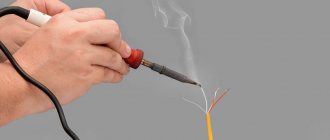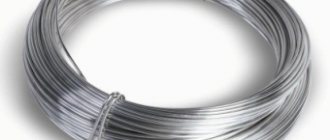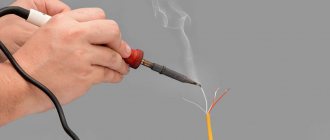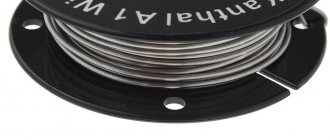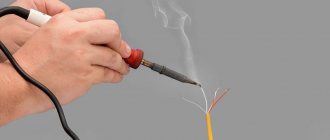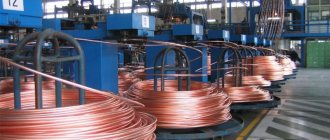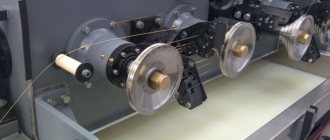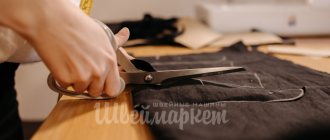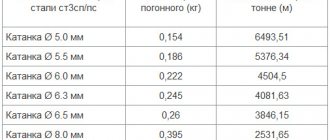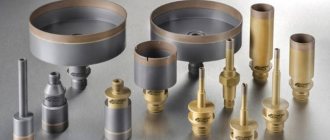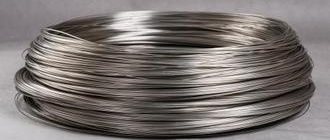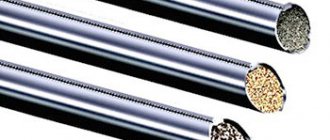Basic properties of copper wire
To create wire, pure grades of copper are usually used - M3, M2, M1, M0 and higher (that is, grades with a copper content of more than 99%).
Production is carried out in a factory manner, and various ores or recyclable materials are used as feedstock. Based on their structure, there are two main types of wire: soft and hard. The soft one is suitable for engineering applications, while the hard one is often used for decorative purposes.
Properties
- Low material resistivity (P-value is 0.0175). Thanks to this, electric current easily passes through the metal, and the conductor does not heat up.
- Quite high density of copper wire (about 9 g per 1 cubic centimeter). Because of this, the material is light in weight and has a dense structure.
- Corrosion resistance. Thanks to this, the material does not rust or deteriorate during storage.
Where can I get copper wire at home? The wire is part of electric motors and electricity transformers. Therefore, it can be found in any electrical appliances - TVs, hair dryers, irons, vacuum cleaners and so on.
Copper wire is also very often used as a conductor of electrical current, so it can be found in wires and cables. Please note that cable copper is usually covered with a special protective sheath, which is difficult to remove manually. Whereas on transformers and electric motors the winding is in its pure form (insulation in this case is not required for technical reasons).
Wire brands
The marking of the wires contains instructions on the material design. If the designation does not contain the letter “A”, then the product is made of copper. The most popular brands are:
PBPP (PUNP) - the abbreviation stands for household, industrial flat wire. This product has a cross section of up to 6 sq. mm with PVC insulation. Operates in the range from -15 degrees to +50 degrees. Suitable for installation of lighting systems.
Buy power cable VVGnglsElectrical wiring diagram in the garage - features of design and installation with your own hands. 120 photos of wiring examples and video instructions for replacing wiring in the garage
Which wire to use for grounding: calculation of parameters, marking and purpose of various types of wires (video instructions + 150 photos)
PBPPg (PUGNP) - unlike the previous one, contains stranded conductors. In the name, the letter “g” means flexible. The smallest bending radius is equal to six diameters. Otherwise similar to PBPP. Sold in coils of 100 m, 200 m.
PPV is a flat wire with an insulating layer of PVC plastic. The number of cores can be from 2 to 3 pieces, the cross-section being 0.75-6 sq. mm. Operates on AC or DC voltages of 450 V and 1000 V, respectively. Temperature operating conditions from -50 degrees to +70 degrees. Found application in the installation of lighting systems and power lines.
PVA is a heat-resistant, wear-resistant stranded conductor with colored PVC insulation. The cross-section ranges from 0.75 sq. mm to 16 sq. mm. Network parameters - voltage 380 V, frequency 50 Hz. Used for installing sockets and producing extension cords.
Areas of application
- Copper wire for winding various transformers and energy generators. For such purposes, wire of small or medium diameter with a high specific copper content (more than 99.5%) is usually used. Thanks to this, electric current passes through the conductor freely and without delay, which improves the technical and operational characteristics of transformers and generators.
- Creation of cables and conductors of electric current. Copper wire is also widely used to create conductors, since copper conducts electric current very well and heats up slightly during operation.
- For needlework and creating frame structures for decorative purposes. You can make various decorative items - rings, frame products in the form of animals, wicker toys, and so on. Copper craft wire of grades M3 and higher has become widespread in this area. The specific copper content in this case is not too important.
The wire is also used for welding copper and brass products. You need to select the grade of copper depending on the composition of the original parts that will be welded. If the original parts and the welding wire have different compositions, then the quality of the weld will not be very high, which can lead to cracking and damage to the material.
Marking
Special designations clearly show what copper wire is needed for:
- M1 or M1r - automated electric welding in a chemically stable environment, production of electrodes;
- M2r - gas welding of universal copper products;
- MSr1 - responsible gas welding work (as well as the production of electrical devices);
- MNZH5-1 - production of welding electrodes;
- BrAMts9-2 - manual welding of some alloys in a protective environment, manual and mechanized surfacing on steel;
- BrKh0.7 - automatic electric welding of bronze based on chromium under a layer of flux;
- MML - for electrical purposes and conductors;
- MS - creation of overhead communication lines.
Resistance calculation
Electrical resistance is of particular importance in situations where the wire is used as a winding for transformers and generators. After all, if the resistance is too high, then in the event of an emergency, the winding may ignite, which can lead to catastrophic consequences.
Resistance formula
To accurately calculate resistance, use the following formula: R = (P x L)/S. It deciphers like this:
- R is the total resistance. We need to find this parameter as a result of calculations (units of measurement - Ohm).
- P is the resistivity of the material. This indicator is a physical constant, and it depends on the type of chemical element. For copper the constant P will be equal to 0.0175 (units - (Ohm x mm x mm)/m).
- L is the total length in meters. The larger it is, the higher the resistance of the conductor will be.
- S is the cross-sectional area in square millimeters. This parameter also affects the final resistance - the smaller it is, the higher the resistance will be.
Please note that the parameter S is usually indicated in the technical documentation, but instead of the cross-sectional area, sometimes only the cross-sectional diameter of the wire is indicated. In this case, it is necessary to calculate the area using the formula: S = (Pi xdxd)/4. This formula is deciphered as follows:
- Pi is a mathematical constant that is approximately equal to 3.14.
- d is the cross-sectional diameter of the conductor in millimeters.
As a result, the resistance of copper wire is measured using two formulas: R = (P x L)/S = (4 x P x L)/(Pi xdxd).
Examples of problems
Let's try to solve a few simple problems:
- Task 1. Determine the resistance of a wire whose length is 100 meters and cross-sectional area is 5 square millimeters. In our problem, the area parameter is known, so we will use the first formula R = (P x L)/S. Let's substitute our values: R = (0.0175 x 100)/5 = 0.35 Ohm.
- Task 2. Determine the resistance of a wire whose length is 500 meters and cross-sectional diameter is 2 millimeters. In this problem the diameter is known, so we will use the second formula R = (4 x P x L)/(Pi xdxd). Let's substitute our values: R = (4 x 0.0175 x 500)/(3.14 x 2 x 2) = 2.78 Ohm.
Wire drawing
For production at factories, a special casting technology is used, which makes it possible to obtain copper wire with a cross-sectional diameter of about 20-30 millimeters. This figure is quite high, since such a thick wire has a lot of disadvantages - high specific gravity, high resistivity of the material, and so on.
Therefore, after casting, drawing is also used. This technology allows you to reduce the diameter of the product to the required parameters (from 1-2 micrometers with ultra-fine drawing to 10 millimeters with coarse drawing). The drawing technology itself is quite simple: thick wire is passed through special holes (dies), the diameter of which is less than the diameter of the original wire.
Technology
Drawing requires special drawing machines, as well as adherence to a certain procedure.
- Immediately before drawing, the original wire must undergo an etching procedure. For this, a solution of hydrochloric acid is usually used, which is heated to low temperatures (40-50 degrees Celsius). After etching, it is also recommended to anneal the metal workpiece - this will make the metal fine-grained, which will allow for better drawing. After annealing, it is necessary to neutralize the remaining etching acid and rinse. Pickling and annealing can significantly increase the service life of drawing machines - if this is not done, the drawing holes-dies will quickly become clogged with scale, which will slow down the production process.
- Now you can proceed directly to drawing. To do this, the ends of the original wire are sharpened using forging tools, and then the wire is inserted into special die holes. After this, the engine of the drawing machine is started. To obtain thin or ultra-fine wire of small cross-section, it is successively passed through several dies.
- At the last stage of processing, the wire becomes quite rigid and springy. To get rid of this drawback, final annealing of the material occurs in the last compartment of the drawing machine. At the end, drying is carried out in special cabinet compartments - after this, winding is carried out on reels. Drawing is completed - the wire spools can now be placed in a warehouse and delivered to the customer using vehicles.
Automation
The drawing procedure is semi-automated - the operator only prepares and threads the initial wire, and the machine itself performs the drawing itself in automatic mode (although the operator can control the procedure parameters using the control panel).
In some cases, special lubricants can be applied before drawing - these can be fatty oils, emulsion inhibitors, solutions of alkaline salts, and so on. The purpose of applying a lubricant is to reduce friction during drawing - this allows you to obtain a thinner and more uniform wire + by applying a lubricant, the risk of ruptures is minimized.
Remelting
Waste or deformed copper wire can be melted down in special industrial furnaces. After remelting, copper must also go through several stages of purification to rid the material of various impurities. In factories this happens as follows:
- Scrap copper metal is cleaned from the windings and placed in special vats where the material is heated.
- To increase the temperature, oxygen is injected.
- As a result of this operation, the temperature rises sharply, which leads to complete melting of the copper and burnout of all major impurities.
- After this, special hoods are turned on, which leads to rotation of the vat of metal - due to this, the copper is separated from the refractory debris.
- Now the copper is poured into molds and, after cooling slightly, placed in water baths to form solid ingots.
- After this, the copper is placed in special electrolysis baths - this allows you to get rid of various metal impurities (gold, silver, aluminum, tellurium and other elements).
- Then small plates are formed, which are then sent for remelting - at the end, a thick wire is formed from molten copper by casting (after cooling, its diameter can be reduced using drawing in the standard way).
Please note that in factories, copper goes through several stages of purification - which is why melting copper at home makes little sense. Yes, theoretically, you can heat copper at home to the required temperatures, followed by melting the metal. However, at home it is practically very difficult to clean without special equipment.
Copper wire welding
Used for welding products and sheets based on copper or brass alloys. Copper wire in this case is used as a substrate from which the weld will be formed. Let's consider the critical points of the main welding methods:
Gas welding
For gas welding of copper, it is recommended to use boron-based flux solutions to quickly remove oxides in order to improve the quality of the weld and minimize the formation of air bubbles inside the weld.
It is necessary to monitor gas consumption depending on the thickness of the alloy. If the thickness of the object is less than 1 cm, then the gas consumption will be 150-160 l/hour. If the thickness of the object is more than 1 cm, then the consumption will be about 200-250 liters.
Welding is recommended to be done with quick but precise movements. Melting should be done like this: first the filler wire is melted - then the edges of the copper objects are melted.
Semi-automatic welding
Semi-automatic welding is recommended to be done in a flux environment to minimize the risk of air bubbles. The optimal wire for welding is M2, although grades M1 and M3 can also be used.
For semi-automatic welding, it is recommended to use a voltage of 30 volts and a current of 300 amperes. Welding is recommended to be done with transverse movements, but without sudden vibrations. Otherwise, air bubbles and harmful oxides may form, which will adversely affect the quality of the weld.
Argon arc welding
This welding method is optimal. By using argon, the risk of formation of oxides and air bubbles is reduced, which makes the seam smooth and solid. For welding, you need to use electrodes based on tungsten alloys. Electrodes on a different base are quickly destroyed and can contaminate the seam. For welding, it is recommended to use reverse polarity current. If the copper product has a large and medium thickness, then a slight heating must be performed before welding. When working with thin products, preheating may not be necessary.
Peculiarities
Modern copper wire looks like similar products made from other metals, similar to a thin string. In such cases, technologists talk about a very small cross-section. Most often, industrial production of copper wire is carried out by hot or cold deformation. There are almost no impurities in its composition; it must contain copper of exclusively pure varieties. The current GOST for copper wire came into force on January 1, 1992.
According to the standard, production must be carried out according to the principles of current technological regulations. The diameters, the level of deviations, the proximity of the wire and rods to the oval shape are standardized. The surface plane of products must invariably be clean and smooth. Not acceptable according to the standard:
- cracks;
- such type of defects as sunsets;
- ruptures;
- rolling films (if the depth exceeds the standard deviations from the diameter).
But here is what may well be present without violating established norms:
- reddened areas remaining after etching;
- coloring in faded tones;
- small inclusions of process lubricants.
It is imperative to remove remaining tensile stresses. This is achieved by annealing at low temperatures or mechanical processing. Removing such defects is a critical component in technology design. Mixing up wire rows and creating bends is not recommended. The tying is carried out in such a way that the density of the rows is not disturbed.
For 100% of skeins, drums or other packaging, only one piece of wire should be used.
Transportation and storage
Rules for storing copper wire are regulated by GOST standards. Basic Rules:
- The optimal method of storage and transportation is the use of frame bays. For transportation, the coils must be packed in a special film. It will protect the material from adverse environmental conditions. In most cases, coils can be stored in a fold without packaging.
- The wire must be stored in special warehouses. The basic requirements for storage are low humidity, dry ventilation, minimal risk of prolonged wetting of the material (short-term wetting due to carelessness is allowed), and so on.
- Different grades of copper should be stored separately in the warehouse. If the wire becomes tangled during transportation, untangling is necessary. When unraveling, under no circumstances should the material be allowed to twist in a figure eight pattern.
How to clean?
Even the best copper wire is inevitably covered with a layer of oxides during everyday use. Other contaminants may also accumulate on it. A very good cleaning method is to place the wire in a 70% vinegar solution. The dirty item must be boiled in such a solution; the liquid should be slightly above the level of the metal. “Cooking” takes 30 minutes, after which the wire is washed with water and the oxide is removed from it purely mechanically.
Minor stains can be removed with tomato ketchup. But you cannot count on cleaning this way in case of serious oxidation. The most effective option has long been recognized as using an ammonia solution (at a concentration of 10%). Keep the part in this solution for no more than 10 minutes. After processing, it is thoroughly washed and mechanically cleaned.
